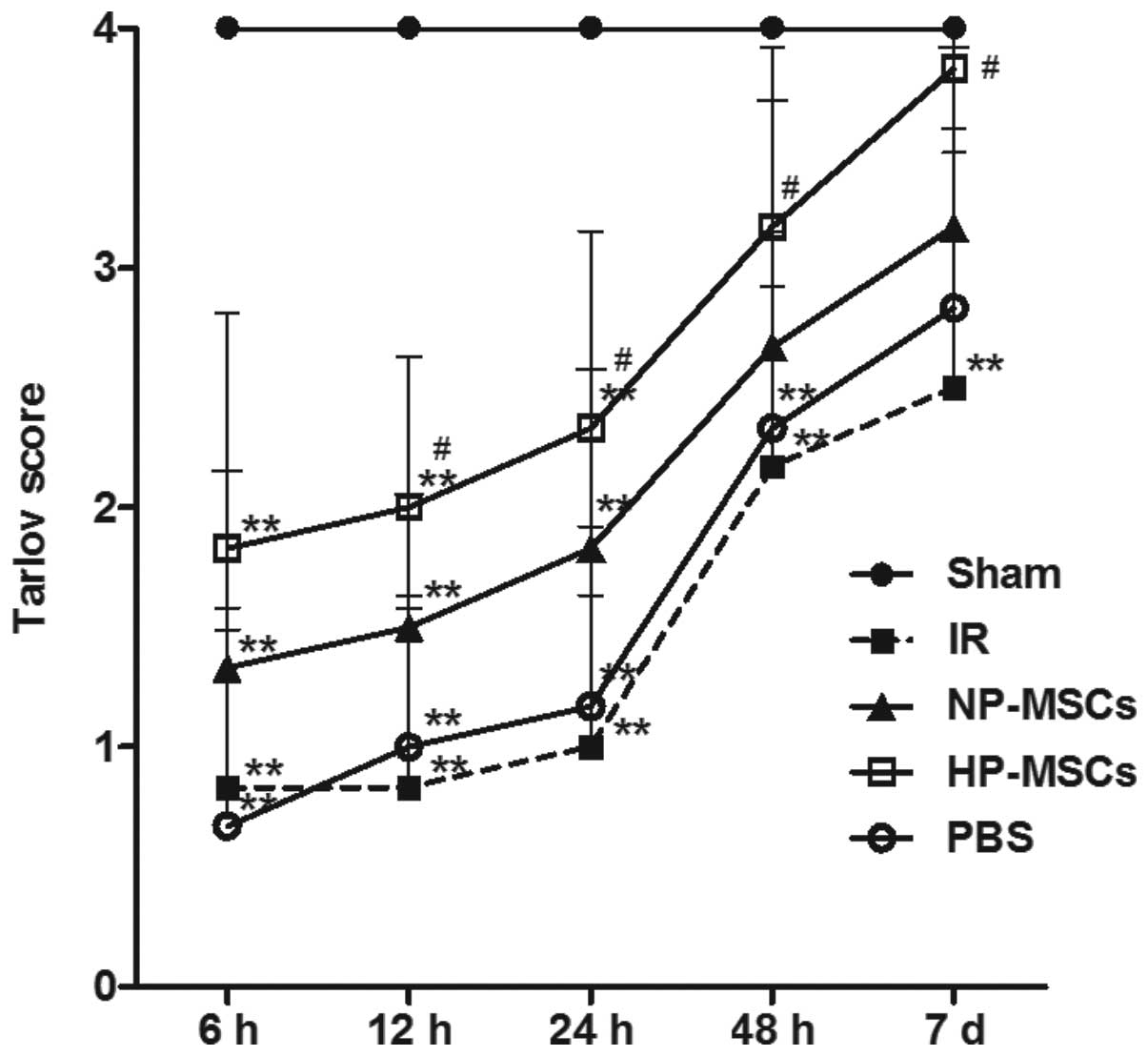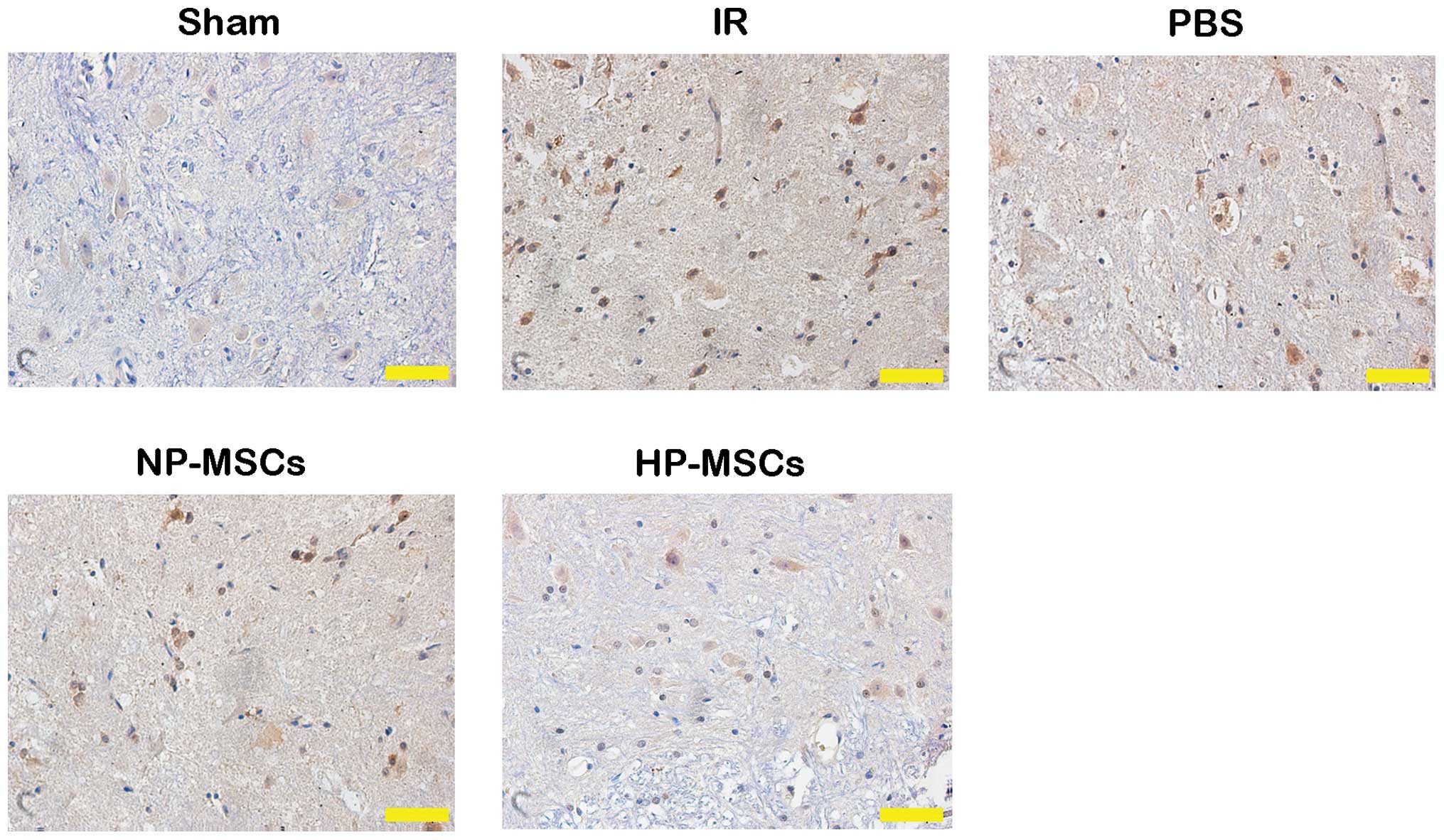|
1
|
Weir CJ, Zivin JA and Lyden PD:
Inter-relationships between spinal cord blood flow, neuronal death
and neurological function in rabbit spinal cord ischemia. Brain
Res. 946:43–51. 2002. View Article : Google Scholar : PubMed/NCBI
|
|
2
|
Kuniyoshi Y, Koja K, Miyagi K, Shimoji M,
Uezu T, Arakaki K, Yamashiro S, Mabuni K, Senaha S and Nakasone Y:
Prevention of postoperative paraplegia during thoracoabdominal
aortic surgery. Ann Thorac Surg. 76:1477–1484. 2003. View Article : Google Scholar : PubMed/NCBI
|
|
3
|
MacArthur RG, Carter SA, Coselli JS and
LeMaire SA: Organ protection during thoracoabdominal aortic
surgery: Rationale for a multimodality approach. Semin Cardiothorac
Vasc Anesth. 9:143–149. 2005. View Article : Google Scholar : PubMed/NCBI
|
|
4
|
Sinha AC and Cheung AT: Spinal cord
protection and thoracic aortic surgery. Curr Opin Anaesthesiol.
23:95–102. 2010. View Article : Google Scholar
|
|
5
|
Mauney MC, Blackbourne LH, Langenburg SE,
Buchanan SA, Kron IL and Tribble CG: Prevention of spinal cord
injury after repair of the thoracic or thoracoabdominal aorta. Ann
Thorac Surg. 59:245–252. 1995. View Article : Google Scholar : PubMed/NCBI
|
|
6
|
Shi E, Kazui T, Jiang X, Washiyama N,
Yamashita K, Terada H and Bashar AH: Intrathecal injection of bone
marrow stromal cells attenuates neurologic injury after spinal cord
ischemia. Ann Thorac Surg. 81:2227–2233; discussion 2233–2224.
2006. View Article : Google Scholar : PubMed/NCBI
|
|
7
|
Shi E, Kazui T, Jiang X, Washiyama N,
Yamashita K, Terada H and Bashar AH: Therapeutic benefit of
intrathecal injection of marrow stromal cells on ischemia-injured
spinal cord. Ann Thorac Surg. 83:1484–1490. 2007. View Article : Google Scholar : PubMed/NCBI
|
|
8
|
Fang B, Wang H, Sun XJ, Li XQ, Ai CY, Tan
WF, White PF and Ma H: Intrathecal transplantation of bone marrow
stromal cells attenuates blood-spinal cord barrier disruption
induced by spinal cord ischemia-reperfusion injury in rabbits. J
Vasc Surg. 58:1043–1052. 2013. View Article : Google Scholar : PubMed/NCBI
|
|
9
|
Pagani FD, DerSimonian H, Zawadzka A,
Wetzel K, Edge AS, Jacoby DB, Dinsmore JH, Wright S, Aretz TH,
Eisen HJ and Aaronson KD: Autologous skeletal myoblasts
transplanted to ischemia-damaged myocardium in humans. Histological
analysis of cell survival and differentiation. J Am Coll Cardiol.
41:879–888. 2003. View Article : Google Scholar : PubMed/NCBI
|
|
10
|
Toma C, Pittenger MF, Cahill KS, Byrne BJ
and Kessler PD: Human mesenchymal stem cells differentiate to a
cardiomyocyte phenotype in the adult murine heart. Circulation.
105:93–98. 2002. View Article : Google Scholar : PubMed/NCBI
|
|
11
|
Hodgetts SI, Beilharz MW, Scalzo AA and
Grounds MD: Why do cultured transplanted myoblasts die in vivo? DNA
quantifi-cation shows enhanced survival of donor male myoblasts in
host mice depleted of CD4+ and CD8+ cells or Nk1.1+ cells. Cell
transplant. 9:489–502. 2000.PubMed/NCBI
|
|
12
|
Huang X, Su K, Zhou L, Shen G, Dong Q, Lou
Y and Zheng S: Hypoxia preconditioning of mesenchymal stromal cells
enhances PC3 cell lymphatic metastasis accompanied by VEGFR-3/CCR7
activation. J Cell Biochem. 114:2834–2841. 2013. View Article : Google Scholar : PubMed/NCBI
|
|
13
|
Kim HW, Haider HK, Jiang S and Ashraf M:
Ischemic preconditioning augments survival of stem cells via
miR-210 expression by targeting caspase-8-associated protein 2. J
Biol Chem. 284:33161–33168. 2009. View Article : Google Scholar : PubMed/NCBI
|
|
14
|
Peterson KM, Aly A, Lerman A, Lerman LO
and Rodriguez-Porcel M: Improved survival of mesenchymal stromal
cell after hypoxia preconditioning: Role of oxidative stress. Life
Sci. 88:65–73. 2011. View Article : Google Scholar :
|
|
15
|
Liu H, Liu S, Li Y, Wang X, Xue W, Ge G
and Luo X: The role of SDF-1-CXCR4/CXCR7 axis in the therapeutic
effects of hypoxia-preconditioned mesenchymal stem cells for renal
ischemia/reperfusion injury. PloS one. 7:e346082012. View Article : Google Scholar : PubMed/NCBI
|
|
16
|
Chang CP, Chio CC, Cheong CU, Chao CM,
Cheng BC and Lin MT: Hypoxic preconditioning enhances the
therapeutic potential of the secretome from cultured human
mesenchymal stem cells in experimental traumatic brain injury. Clin
Sci (Lond). 124:165–176. 2013. View Article : Google Scholar
|
|
17
|
Carr CA, Stuckey DJ, Tatton L, Tyler DJ,
Hale SJ, Sweeney D, Schneider JE, Martin-Rendon E, Radda GK,
Harding SE, et al: Bone marrow-derived stromal cells home to and
remain in the infarcted rat heart but fail to improve function: An
in vivo cine-MRI study. Am J Physiol Heart Circ Physiol.
295:H533–H542. 2008. View Article : Google Scholar : PubMed/NCBI
|
|
18
|
Yu J, Yin S, Zhang W, Gao F, Liu Y, Chen
Z, Zhang M, He J and Zheng S: Hypoxia preconditioned bone marrow
mesenchymal stem cells promote liver regeneration in a rat massive
hepatectomy model. Stem Cell Res Ther. 4:832013. View Article : Google Scholar : PubMed/NCBI
|
|
19
|
Lang-Lazdunski L, Heurteaux C, Mignon A,
Mantz J, Widmann C, Desmonts J and Lazdunski M: Ischemic spinal
cord injury induced by aortic cross-clamping: Prevention by
riluzole. Eur J Cardiothorac Surg. 18:174–181. 2000. View Article : Google Scholar : PubMed/NCBI
|
|
20
|
Huang Y, Xie K, Li J, Xu N, Gong G, Wang
G, Yu Y, Dong H and Xiong L: Beneficial effects of hydrogen gas
against spinal cord ischemia-reperfusion injury in rabbits. Brain
Res. 1378:125–136. 2011. View Article : Google Scholar : PubMed/NCBI
|
|
21
|
Wang Q, Ding Q, Zhou Y, Gou X, Hou L, Chen
S, Zhu Z and Xiong L: Ethyl pyruvate attenuates spinal cord
ischemic injury with a wide therapeutic window through inhibiting
high-mobility group box 1 release in rabbits. Anesthesiology.
110:1279–1286. 2009. View Article : Google Scholar : PubMed/NCBI
|
|
22
|
Livak KJ and Schmittgen TD: Analysis of
relative gene expression data using real-time quantitative PCR and
the 2(-Delta Delta C(T)) Method. Methods. 25:402–408. 2001.
View Article : Google Scholar
|
|
23
|
De Ugarte DA, Alfonso Z, Zuk PA, Elbarbary
A, Zhu M, Ashjian P, Benhaim P, Hedrick MH and Fraser JK:
Differential expression of stem cell mobilization-associated
molecules on multi-lineage cells from adipose tissue and bone
marrow. Immunol Lett. 89:267–270. 2003. View Article : Google Scholar : PubMed/NCBI
|
|
24
|
Caplan AI and Dennis JE: Mesenchymal stem
cells as trophic mediators. J Cell Biochem. 98:1076–1084. 2006.
View Article : Google Scholar : PubMed/NCBI
|
|
25
|
Kinnaird T, Stabile E, Burnett MS, Lee CW,
Barr S, Fuchs S and Epstein SE: Marrow-derived stromal cells
express genes encoding a broad spectrum of arteriogenic cytokines
and promote in vitro and in vivo arteriogenesis through paracrine
mechanisms. Circ Res. 94:678–685. 2004. View Article : Google Scholar : PubMed/NCBI
|
|
26
|
Das R, Jahr H, van Osch GJ and Farrell E:
The role of hypoxia in bone marrow-derived mesenchymal stem cells:
Considerations for regenerative medicine approaches. Tissue Eng
Part B Rev. 16:159–168. 2010. View Article : Google Scholar
|
|
27
|
Rosová I, Dao M, Capoccia B, Link D and
Nolta JA: Hypoxic preconditioning results in increased motility and
improved therapeutic potential of human mesenchymal stem cells.
Stem Cells. 26:2173–2182. 2008. View Article : Google Scholar : PubMed/NCBI
|
|
28
|
Bernaudin M, Tang Y, Reilly M, Petit E and
Sharp FR: Brain genomic response following hypoxia and
re-oxygenation in the neonatal rat. Identification of genes that
might contribute to hypoxia-induced ischemic tolerance. J Biol
Chem. 277:39728–39738. 2002. View Article : Google Scholar : PubMed/NCBI
|
|
29
|
Pan W and Kastin AJ: Cytokine transport
across the injured blood-spinal cord barrier. Curr Pharm Des.
14:1620–1624. 2008. View Article : Google Scholar : PubMed/NCBI
|
|
30
|
Profyris C, Cheema SS, Zang D, Azari MF,
Boyle K and Petratos S: Degenerative and regenerative mechanisms
governing spinal cord injury. Neurobiol Dis. 15:415–436. 2004.
View Article : Google Scholar : PubMed/NCBI
|
|
31
|
Wang JA, He A, Hu X, Jiang Y, Sun Y, Jiang
J, Gui C, Wang Y and Chen H: Anoxic preconditioning: A way to
enhance the cardiopro-tection of mesenchymal stem cells. Int J
Cardiol. 133:410–412. 2009. View Article : Google Scholar
|
|
32
|
Li JH, Zhang N and Wang JA: Improved
anti-apoptotic and anti-remodeling potency of bone marrow
mesenchymal stem cells by anoxic pre-conditioning in diabetic
cardiomyopathy. J Endocrinol Invest. 31:103–110. 2008. View Article : Google Scholar : PubMed/NCBI
|
|
33
|
He A, Jiang Y, Gui C, Sun Y, Li J and Wang
JA: The anti-apoptotic effect of mesenchymal stem cell
transplantation on ischemic myocardium is enhanced by anoxic
preconditioning. Can J Cardiol. 25:353–358. 2009. View Article : Google Scholar : PubMed/NCBI
|
|
34
|
Majmundar AJ, Wong WJ and Simon MC:
Hypoxia-inducible factors and the response to hypoxic stress. Mol
Cell. 40:294–309. 2010. View Article : Google Scholar : PubMed/NCBI
|
|
35
|
Kanichai M, Ferguson D, Prendergast PJ and
Campbell VA: Hypoxia promotes chondrogenesis in rat mesenchymal
stem cells: A role for AKT and hypoxia-inducible factor
(HIF)-1alpha. J Cell Physiol. 216:708–715. 2008. View Article : Google Scholar : PubMed/NCBI
|
|
36
|
Liu H, Xue W, Ge G, Luo X, Li Y, Xiang H,
Ding X, Tian P and Tian X: Hypoxic preconditioning advances CXCR4
and CXCR7 expression by activating HIF-1alpha in MSCs. Biochem
Biophys Res Commun. 401:509–515. 2010. View Article : Google Scholar : PubMed/NCBI
|
|
37
|
Ma D, Lim T, Xu J, Tang H, Wan Y, Zhao H,
Hossain M, Maxwell PH and Maze M: Xenon preconditioning protects
against renal ischemic-reperfusion injury via HIF-1alpha
activation. J Am Soc Nephrol. 20:713–720. 2009. View Article : Google Scholar : PubMed/NCBI
|
|
38
|
Singh N, Sharma G and Mishra V: Hypoxia
inducible factor-1: Its potential role in cerebral ischemia. Cell
Mol Neurobiol. 32:491–507. 2012. View Article : Google Scholar : PubMed/NCBI
|
|
39
|
Hirota K: Hypoxia-inducible factor 1, a
master transcription factor of cellular hypoxic gene expression. J
Anesth. 16:150–159. 2002. View Article : Google Scholar
|















